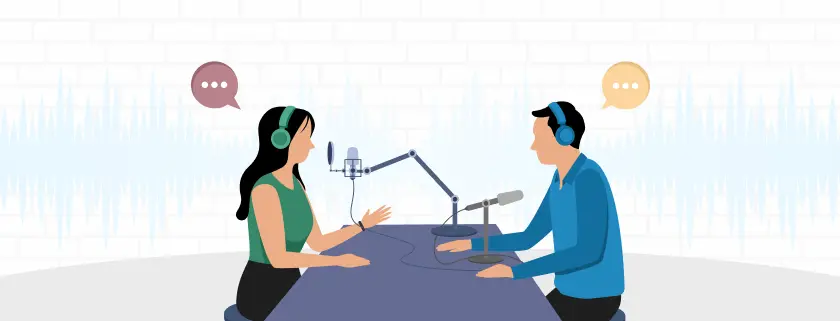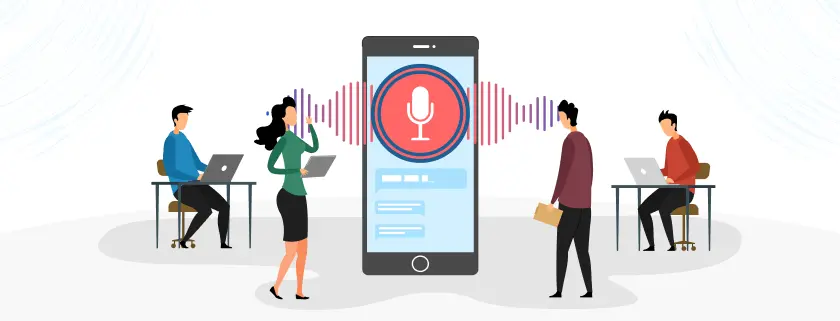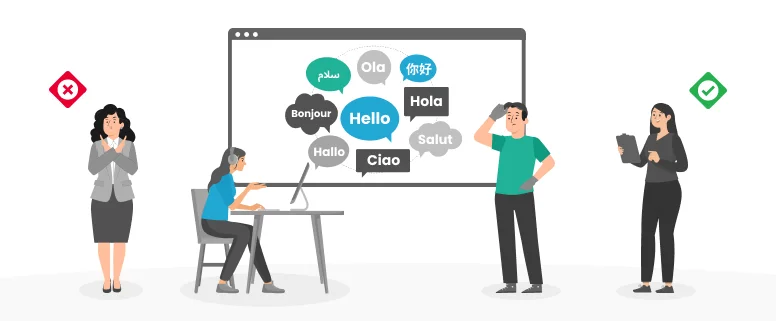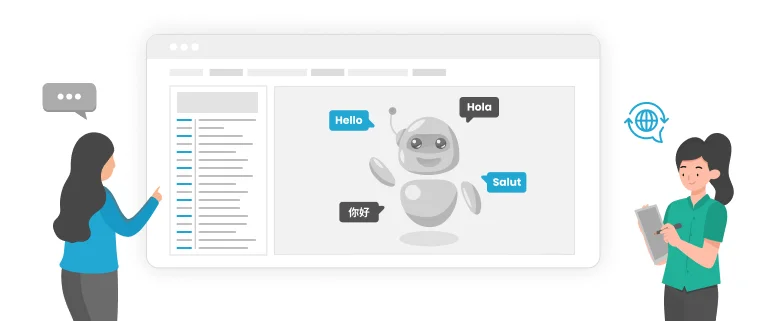Voice-over and dubbing are simply two sides of the same coin. Both are used to re-version audiovisual content for new audiences or new markets.
Probably, this is why most people frequently use them interchangeably.
But are they exactly the same thing? In a word, NO.
Despite how similar we may think they are, in reality, they are not. There are many differences between the two.
Keep reading if you want to learn the key differences between them, as well as their types, benefits, and when to use which one.
Let’s get there step by step!
Table of Content
The Concept of Voice-over: What’s it?
As the name implies, voice-over is a voice, over another voice.
This is common in documentaries or interviews, for example, where a voice is added on top of the original speaker. You hear the original voice for a second or two, but it then drops out for the translator’s voice to appear.
The purpose of this language technique is to clearly relay what the original speaker was saying to the new audience.
Kinds of Voice-over:
There are basically two types of voice-over translations. If you know what each one is about, you may use them more successfully for your video content initiatives.
Understanding what each one is about will help you use them more effectively for your video content projects.
UN-style voice-over: In UN-style, the original voice is kept at a low volume, overlaid with another in a different language.
Off-camera voice-over: The off-camera voice-over, also known as narration, is when a voice is used to describe all the actions on screen, either from the perspective of a character or a third party.
UN-style voice-over is the most common and popular type of voice-over. And, in general, when we talk about the voice-over, we mostly mean the UN style.
The Concept of Dubbing: What’s it?
Dubbing is a complete replacement of one audio by another audio to try to intimate the original soundtrack.
That’s why dubbing is also known as “language replacement”.
The purpose of this technique is to strip away the spoken audio of the original TV program or movie. And replace it entirely with new, re-versioned audio in French, Japanese, Chinese, or any other target language. This creates the impression in viewers’ minds that the television show or movie they are viewing was actually filmed and produced in their language.
Kinds of Dubbing:
Dubbing usually takes one of the following two forms.
1. Voice Replacement: The original audio is replaced here, but no or little effort is made to replicate the on-screen lip movements.
2. Lip-syncing: It’s the most difficult form of dubbing and requires precise timing of audio to match lip flaps, gestures, and postures of people on screen.
Voice-over vs Dubbing: What are the Major Differences?
So, you need to understand the fundamental differences between voice-over and dubbing. In order to answer how one is distinct from the other, let’s consider the following criteria.
i) Emotions and Tonality:
Voice-over is narrative in nature, primarily focussing on conveying the information. Hence, it lacks emotions and tonality. Dubbing on the other hand puts a lot of emphasis on the tone, emotional depth, and delivery of the content.
ii) Visibility:
In the voice-over, the narrative is placed along with the re-versioned audio, so it’s noticeable. While dubbing involves the same audio in a different language than the original. As it tries to create an illusion for viewers, users can’t easily detect that the content is dubbed.
iii) Translation and Storytelling:
Voice-overs can be used for creative storytelling or as a tool for quickly and directly translating and passing on information to the audience. However, dubbing is similar to the translation of one language to another. And works best when the primary goal is to stick to the original information.
iv) Content Priorities:
The voice-over is a preferred option for videos with a shorter duration. Such as interviews, documentaries, and corporate videos which are informative in nature. Dubbing on the other hand is most popular for longer durations, like big-budget films and other entertainment content.
v) Engaging Experience:
In essence, voice-over does not trigger human emotion while dubbing does. Since dubbing pays so much attention to tonality, varying expressions, feelings, dialects, and other nuances. It creates a wholesome, engaging viewer experience.
Voice-over or Dubbing: Which Method should I choose?
It’s tricky to answer which audiovisual translation method would be best for you. In fact, there’re many unique factors that, if you consider them carefully, can help guide the best approach to take.
i) Genre and Purpose:
Assess whether your content seeks to entertain or is it informative? For instance, it’s best to use voice-over for something like a documentary or any instructional or advertising content. Since dubbing, especially lip-synching, creates an immersive experience, it would be an ideal choice for feature films and TV shows, etc.
ii) Budget and Timeframe:
Dubbing is extremely complicated and time-consuming, so you’re bound to pay more. Doing voice-over, on the other hand, is a relatively easy job compared to dubbing. It takes a short time to complete and costs you less.
iii) Target Country:
Many nations prefer one method of language adaptation over another. For example, people in Spain are more accustomed to consuming foreign-language material in dubbed form. So, you can pay attention to which country your content is going to target. Before reaching the final decision.
To summarize, you should thoroughly review all your project requirements to choose a better approach for your content.
Big Benefits of Voice-over and Dubbing:
No matter which one you pick, voice-over and dubbing are both highly beneficial in their own way. Now we’ll go over some of the most important advantages these language services have to offer for your business.
a) Let your Content Travel the World:
Both voice-over and dubbing are great ways to break the language barriers so you can reach new geographies. By using these techniques, your content will travel the world, thus opening up a new world of opportunities for your global business.
b) Keep your Audience Captivated:
By including a perfect voice-over or dubbed video, you can make it possible for your audience to consume the content in their native language. This will significantly boost user engagement and help them develop a solid emotional connection with your content as they absorb it.
c) Increased ROI through Localization:
Studies show that businesses that localize their content benefit from increased ROI. Because users are more likely to trust brands, that communicate with them in their local language, than those that do not. As a result, when you use voice-over and dubbing to translate and localize your video content, you can expect a higher return on investment.
Final Remarks
The voice-over and dubbing are described as two sides of the same coin. They are part of the same creative stream: making audiovisual content understandable and accessible to a wider worldwide audience.
Now that you know the difference between voice-over and dubbing, their types, and are also aware of which service is a good candidate for what purpose. All you need to do is: think about how would you like to localize your content.
At CCJK, we’ve over two decades of experience providing professional language services and can meet all your requirements, whether you need voice-over or dubbing services. We can even advise you on what could be the best option for your content. Just contact us and we will be glad to assist you.
Read More:
1. How to Implement Effective Localization of Voice-over?
2. Chinese & Korean Translation and Voiceover
3. The Industry of Dubbing and Subtitling in the Light Of Netflix’s Rise
4. All You Need to Know About Movie Dubbing









